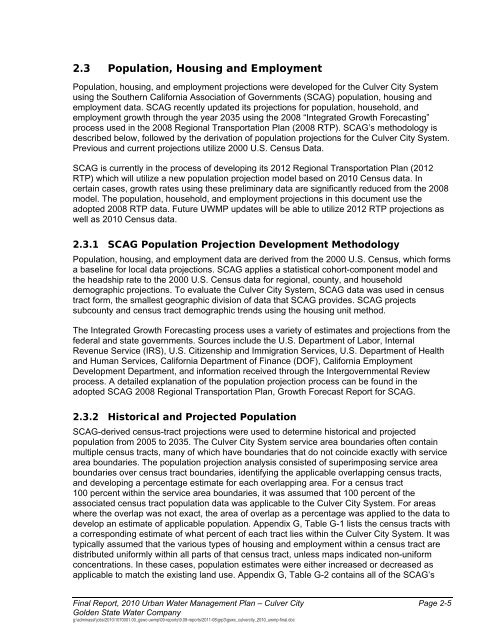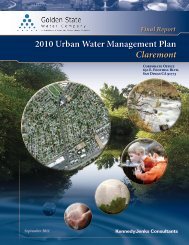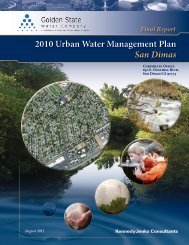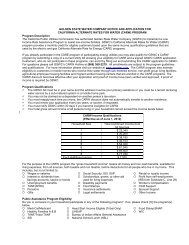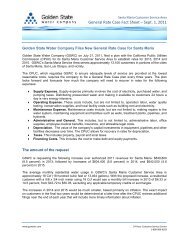Final Report, 2010 Urban Water Management Plan - Culver City
Final Report, 2010 Urban Water Management Plan - Culver City
Final Report, 2010 Urban Water Management Plan - Culver City
You also want an ePaper? Increase the reach of your titles
YUMPU automatically turns print PDFs into web optimized ePapers that Google loves.
2.3 Population, Housing and EmploymentPopulation, housing, and employment projections were developed for the <strong>Culver</strong> <strong>City</strong> Systemusing the Southern California Association of Governments (SCAG) population, housing andemployment data. SCAG recently updated its projections for population, household, andemployment growth through the year 2035 using the 2008 “Integrated Growth Forecasting”process used in the 2008 Regional Transportation <strong>Plan</strong> (2008 RTP). SCAG’s methodology isdescribed below, followed by the derivation of population projections for the <strong>Culver</strong> <strong>City</strong> System.Previous and current projections utilize 2000 U.S. Census Data.SCAG is currently in the process of developing its 2012 Regional Transportation <strong>Plan</strong> (2012RTP) which will utilize a new population projection model based on <strong>2010</strong> Census data. Incertain cases, growth rates using these preliminary data are significantly reduced from the 2008model. The population, household, and employment projections in this document use theadopted 2008 RTP data. Future UWMP updates will be able to utilize 2012 RTP projections aswell as <strong>2010</strong> Census data.2.3.1 SCAG Population Projection Development MethodologyPopulation, housing, and employment data are derived from the 2000 U.S. Census, which formsa baseline for local data projections. SCAG applies a statistical cohort-component model andthe headship rate to the 2000 U.S. Census data for regional, county, and householddemographic projections. To evaluate the <strong>Culver</strong> <strong>City</strong> System, SCAG data was used in censustract form, the smallest geographic division of data that SCAG provides. SCAG projectssubcounty and census tract demographic trends using the housing unit method.The Integrated Growth Forecasting process uses a variety of estimates and projections from thefederal and state governments. Sources include the U.S. Department of Labor, InternalRevenue Service (IRS), U.S. Citizenship and Immigration Services, U.S. Department of Healthand Human Services, California Department of Finance (DOF), California EmploymentDevelopment Department, and information received through the Intergovernmental Reviewprocess. A detailed explanation of the population projection process can be found in theadopted SCAG 2008 Regional Transportation <strong>Plan</strong>, Growth Forecast <strong>Report</strong> for SCAG.2.3.2 Historical and Projected PopulationSCAG-derived census-tract projections were used to determine historical and projectedpopulation from 2005 to 2035. The <strong>Culver</strong> <strong>City</strong> System service area boundaries often containmultiple census tracts, many of which have boundaries that do not coincide exactly with servicearea boundaries. The population projection analysis consisted of superimposing service areaboundaries over census tract boundaries, identifying the applicable overlapping census tracts,and developing a percentage estimate for each overlapping area. For a census tract100 percent within the service area boundaries, it was assumed that 100 percent of theassociated census tract population data was applicable to the <strong>Culver</strong> <strong>City</strong> System. For areaswhere the overlap was not exact, the area of overlap as a percentage was applied to the data todevelop an estimate of applicable population. Appendix G, Table G-1 lists the census tracts witha corresponding estimate of what percent of each tract lies within the <strong>Culver</strong> <strong>City</strong> System. It wastypically assumed that the various types of housing and employment within a census tract aredistributed uniformly within all parts of that census tract, unless maps indicated non-uniformconcentrations. In these cases, population estimates were either increased or decreased asapplicable to match the existing land use. Appendix G, Table G-2 contains all of the SCAG’s<strong>Final</strong> <strong>Report</strong>, <strong>2010</strong> <strong>Urban</strong> <strong>Water</strong> <strong>Management</strong> <strong>Plan</strong> – <strong>Culver</strong> <strong>City</strong> Page 2-5Golden State <strong>Water</strong> Companyg:\adminasst\jobs\<strong>2010</strong>\1070001.00_gswc-uwmp\09-reports\9.09-reports\2011-08\grp3\gswc_culvercity_<strong>2010</strong>_uwmp-final.doc


